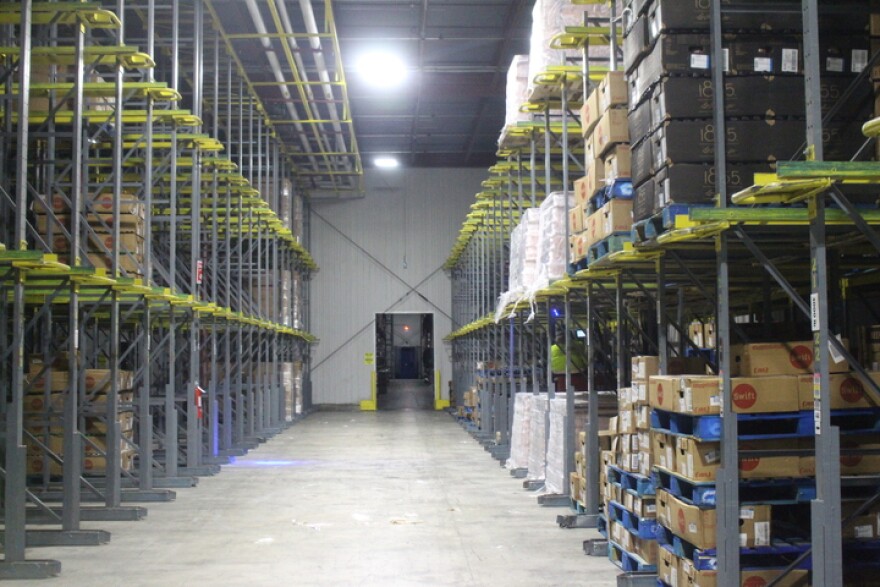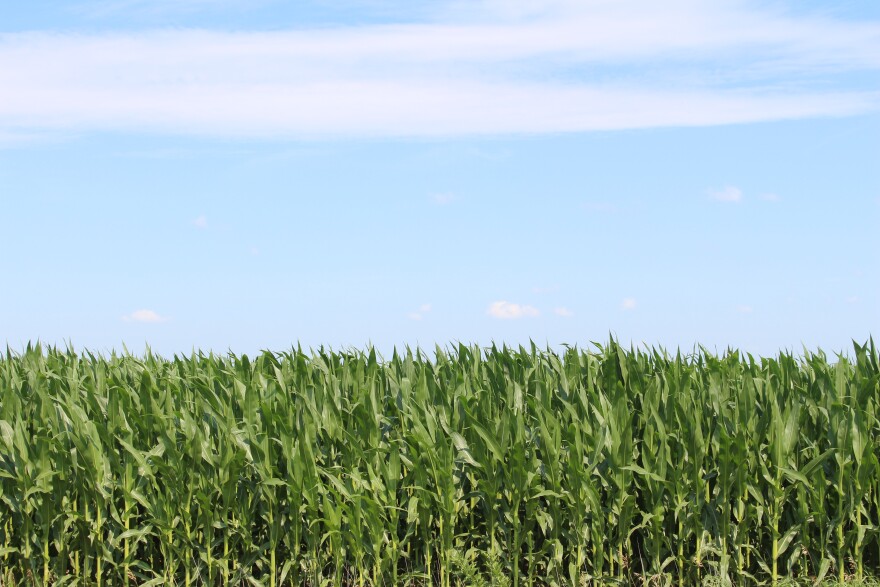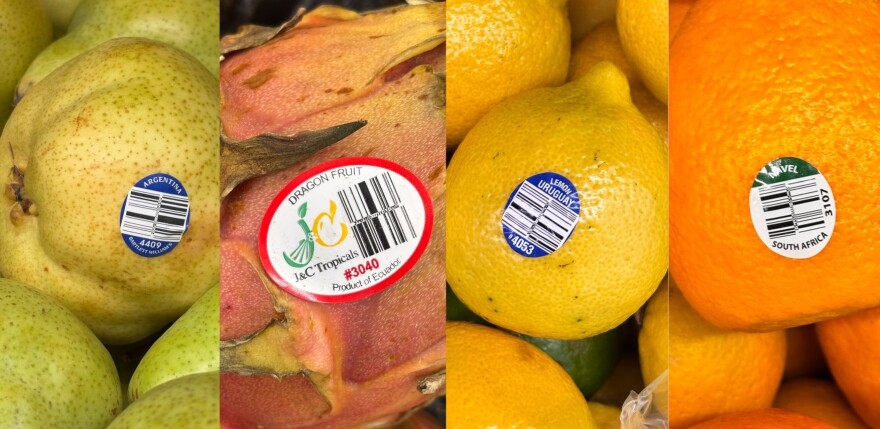This story is part of Food Routes, a Harvest Public Media series about local food.
Stop at the produce section at your local grocery store and you’ll take a small trip around the world. Bananas from Ecuador and Costa Rica. Tomatoes, avocados and asparagus from Mexico. Bell peppers from Canada.
That wasn’t always the case.
Go back a century, and most of the food eaten in a household came from farms within a few hundred miles of the home. Once temperature-controlled transportation was introduced in the mid 1900s, perishable items were able to travel farther. Then, in recent decades, U.S. consumers expanded their palates as favorable trade agreements led to a spike in imported goods.
Now, even as interest and investment in local food systems grows, the U.S. is on track for the largest agricultural trade deficit in the country’s history.
Experts say that shift is due to a mix of advancements in transportation technology, crop specialization, increased international trade and – perhaps most importantly – consumer desires.
“When you look at the grocery store shelves, it’s a combination of what we can grow and what we can trade for,” said Chad Hart, an agronomist with Iowa State University, “but ultimately, it comes back to what U.S. consumers want.”
The ‘cold chain’ revolution
As temperatures reached near triple-digits on a humid Nebraska day, Billy Ward was decked out in a heavy-duty coat.
Ward is the manager of a massive cold storage warehouse in Grand Island run by Lineage, one of the largest temperature-controlled warehousing companies in the world. The company has more than 480 warehouses in 17 countries, including dozens of locations in the Midwest.
The Lineage facility in central Nebraska almost exclusively stores beef from nearby packing plants before it’s shipped around the country and the world. On a Tuesday in July, Ward was preparing to ship orders to the Ivory Coast, Egypt and Korea.
“Lineage as a whole handled more than 158 billion pounds of food traveling through our global network in 2024,” Ward said.

Cold storage warehouses are a critical component of the cold chain, which facilitates the transportation of food across the country and the world. Much of the perishable food imported to the U.S. is stored in these facilities before it makes its way to a grocery store or restaurant.
Sarah Stickler, the president and CEO of the Global Cold Chain Alliance, said much of the food bought by consumers in grocery stores, served in restaurants or even bought at local markets has some interaction with refrigerated storage. The International Fresh Produce Association estimates that 70% of all food consumed by people in the U.S. interacts with the cold chain.
“When we talk about farm-to-table, whether that be protein, whether that be harvests, that’s coming from a farm and going through a process – and most of the time, that process includes cold storage,” Stickler said. “That food is being taken from farms to consumers. That could be within a local community, or it could be miles away.”
That means people on the coasts can eat Nebraska beef, and land-locked Midwesterners eat fish imported from coastal cities.
The shift to row crops
U.S. agricultural exports are dominated by meat and row crops. That is especially true in the Midwest, where the fertile soil and plentiful rainfall make it the prime place for corn and soybean production.
About 75% of all agricultural land in Illinois, Indiana, Iowa, Michigan, Minnesota, Missouri, Ohio and Wisconsin is dedicated to growing corn and soybeans. The heavy emphasis on one or two crops, called specialization, leaves little room for so-called specialty crops like fruits and vegetables.
It wasn’t always this way, Hart said. A century or so ago, a large percentage of Americans were involved in production agriculture, and small farms grew everything that a family or community needed.
While that system worked, it wasn’t economically optimal. People soon learned that it was far more profitable to leverage their skills and land to specialize in a few crops and then trade for what they couldn’t produce themselves.
“We figured out, ‘Hey, if I specialize in a few different things, and I trade with other families in the area that specialize in a few other different things, we can create even more than we did before, still meeting our own needs,” Hart said. “You can think of that system just growing and growing into the system we have today.”
Take Nebraska for example. The soil and climate is suitable for harvesting berries like raspberries and aronia berries, and vegetables like lettuce and radishes. Across the state in 2024, farmers planted about 495 acres of berries and 22,000 acres of vegetables. That’s compared to more than 10 million acres of corn and 5.3 million acres of soybeans.

In theory, the U.S. could produce more than enough food to feed its entire population. President Donald Trump has placed some emphasis on reducing the agricultural trade deficit and decreasing reliance on imports, saying in his executive order implementing broad tariffs that a nation cannot survive if it cannot produce its own food.
But that would leave consumers without the choices they’ve grown accustomed to, according to Luis Ribera, a professor at Texas A&M University and the director of the university’s Center for North American Studies.
“In general terms, can we produce the same amount or more of food that we consume, on a volume basis? Yes, we could,” he said. “But that means that, instead of having a cup of coffee in the morning, we’re going to have to have a cup of soybeans.”
Reliance on trade
The selection of fruits and vegetables available in the produce section has greatly expanded in recent decades, Ribera said.
“Thirty years ago, when I came to the U.S., the produce section looked a lot different than they look right now at the supermarket,” Ribera said. “You didn’t have kiwis, you didn’t really have mangoes.”
Now, Americans can buy limes and papayas and mangoes at a typical grocery store. That’s in part due to favorable trade agreements, like the North American Free Trade Agreement and its replacement, the United States-Mexico-Canada Agreement, which allow tariff- and quota-free trade between the North American countries. Mexico is a major exporter of fresh fruits to the U.S.

It’s also because American consumers have grown accustomed to eating fresh fruits and vegetables year-round, instead of waiting for produce to be in-season as is the case in other countries. Ribera likes to give the example of guacamole – the most popular dip for Super Bowl parties.
“[The Super Bowl] is during our wintertime, and we’re not supposed to have avocados,” he said. “The reason we have them is because of trade.”
While the U.S. remains an agricultural powerhouse, the high percentage of imports for fruits and vegetables has helped contribute to agricultural trade deficits – where the value of imported goods was higher than that of exported goods. As of 2023, according to the USDA, about 60% of fresh fruits and 35% of fresh vegetables consumed in the U.S. were imported.
In 2019, the U.S. experienced its first such trade deficit in more than 60 years. The balance returned to a surplus in 2020 and 2021 before the trade deficit ballooned in 2022. The American Farm Bureau Federation predicts another record-setting deficit this year.
Ribera warns against viewing a trade deficit as inherently negative. The U.S. remains a top exporter of agricultural products, but is increasingly reliant on imports for high-value goods.
“The things we export are more raw products, like grains, for example, and we import more high-value products like fruits and vegetables and spirits and drinks,” Ribera said. “What we’re really good at producing, and what we’re major exporters of, is cotton, sorghum, wheat, soybeans, rice, corn, poultry, beef, pork. When you look at those commodities, we play a major role in the world market.”
Both Ribera and Hart also emphasized that consumer preference likely drives product availability more than any other factor.
“In the end, if U.S. consumers want bananas from Panama, then by God, grocery stores will figure out how to get bananas from Panama,” Hart said.
This story was produced in partnership with Harvest Public Media, a collaboration of public media newsrooms in the Midwest and Great Plains. It reports on food systems, agriculture and rural issues.





